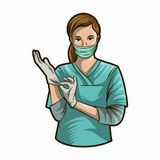

COMMON MEDICAL ABBREVIATIONS PART-2 JT: Joint. K: Potassium. An essential electrolyte frequently monitored regularly in intensive care. KCL: Potassium chloride. LCIS: Lobular Carcinoma In Situ. A type of cancer of the breast. The patient is receiving treatment for Lobular Carcinoma In Situ. LBP: Low back pain. LBP is one of most common medical complaints. LLQ: Left lower quadrant. Diverticulitis pain is often in the LLQ of the abdomen. LUQ: Left upper quadrant. The spleen is located in the LUQ of the abdomen. Lytes: Electrolytes (potassium, sodium, carbon dioxide, and chloride). MCL: Medial collateral ligament. mg: Milligrams. M/H: Medical history ml: Milliliters. MVP: Mitral valve prolapse N/V: Nausea or vomiting. Na: Sodium. An essential electrolyte frequently monitored regularly in intensive care. NCP: Nursing care plan npo: Nothing by mouth. For example, if a patient was about to undergo a surgical operation requiring general anesthesia, they may be required to avoid food or beverage prior to the procedure. NSR: Normal sinus rhythm of the heart O&P: Ova and parasites. Stool O & P is tested in the laboratory to detect parasitic infection in persons with chronic diarrhea. O.D.: Right eye. O.S.: Left eye. O.U.: Both eyes. ORIF: Open reduction and internal fixation, such as with the orthopedic repair of a hip fracture P: Pulse. Pulse is recorded as part of the physical examination. It is one of the "vital signs." p¯: After meals. As in take two tablets after meals. p.o.: By mouth. From the Latin terminology per os. p.r.n.: As needed. So that it is not always done, but done only when the situation calls for it (or example, taking a pain medication only when having pain and not without pain). PCL: Posterior cruciate ligament. PD: Progressive disease. Patients at risk of developing progressive disease of the kidneys include those with proteinuria or hematuria. PERRLA: Pupils equal, round, and reactive to light and accommodation. PFT: Pulmonary function test. A test to evaluate the how well the lungs are functioning. PERRLA: Pupils equal, round, and reactive to light and accommodation. Plt: Platelets, one of the blood forming elements along with the white and red blood cells. PMI: Point of maximum impulse of the heart when felt during examination, as in beats against the chest. PMS: Premenstrual syndrome PT: Physical therapy PTH: Parathyroid hormone PTSD: Post-traumatic stress syndrome PUD: Peptic ulcer disease. A type of ulcer of the stomach. q.d.: Each day. As in taking a medicine daily. q.i.d.: Four times daily. As in taking a medicine four times daily. q2h: Every 2 hours. As in taking a medicine every 2 hours. q3h: Every 3 hours. As in taking a medicine every 3 hours. qAM: Each morning. As in taking a medicine each morning. qhs: At each bedtime. As in taking a medicine each bedtime. qod: Every other day. As in taking a medicine every other day. qPM: Each evening. As in taking a medicine each evening. RA: Rheumatoid arthritis. A type of joint disease. RDS: Respiratory distress syndrome R/O: Rule out. Doctors frequently will rule out various possible diagnoses when figuring out the correct diagnosis. REB: Rebound, as in rebound tenderness of the abdomen when pushed in and then released. RLQ: Right lower quadrant. The appendix is located in the RLQ of the abdomen. ROS: Review of systems. An overall review concerns relating to the organ systems, such as the respiratory, cardiovascular, and neurologic systems. RUQ: Right upper quadrant. The liver is located in the RUQ of the abdomen. s/p: Status post. For example, a person who had a knee operation would be s/p a knee operation. SAD: Season affective disorder. A type of depression that occurs during the winter months when there is little light. SOB: Shortness of breath. SQ: Subcutaneous. This is a typical notation when noting or ordering an injection (shot) given into the fatty tissue under the skin, such as with insulin for diabetes mellitus. T: Temperature. Temperature is recorded as part of the physical examination. It is one of the "vital signs." T&A: Tonsillectomy and adenoidectomy t.i.d.: Three times daily. As in taking a medicine three times daily. tab: Tablet TAH: Total abdominal hysterectomy TAH: Total abdominal hysterectomy. A type of surgery to remove a woman’s uterus, Fallopian tubes, and ovaries. THR: Total hip replacement TKR: Total knee replacement TMJ: Tempomandibular joint UA or u/a: Urinalysis. A UA is a typical part of a comprehensive physical examination. U or u**: Unit. Mistaken as the number 0 or 4, causing a 10-fold overdose or greater (for example, 4U seen as "40" or 4u seen as "44"); mistaken as "cc" so the dose is given in volume instead of units (for example, 4u seen as 4cc). ULN: Upper limits of normal URI: Upper respiratory infection, such as sinusitis or the common cold ut dict: As directed. As in taking a medicine according to the instructions that the health care professional gave in the office or in the past UTI: Urinary tract infection VSS: Vital signs are stable. This notation means that from the standpoint of the temperature, blood pressure, and pulse, the patient is doing well. Wt: Weight. Body weight is often recorded as part of the physical examination. XRT: Radiotherapy (external). A type of treatment that uses radiation

